
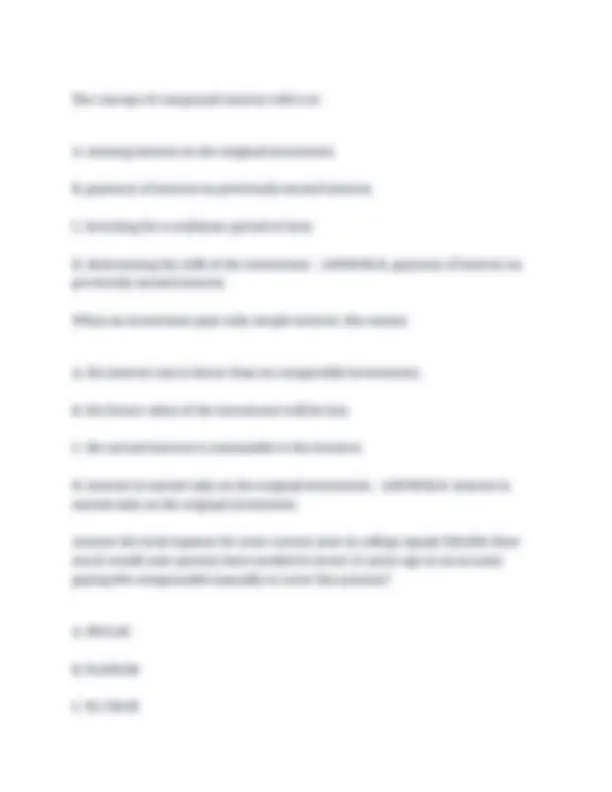
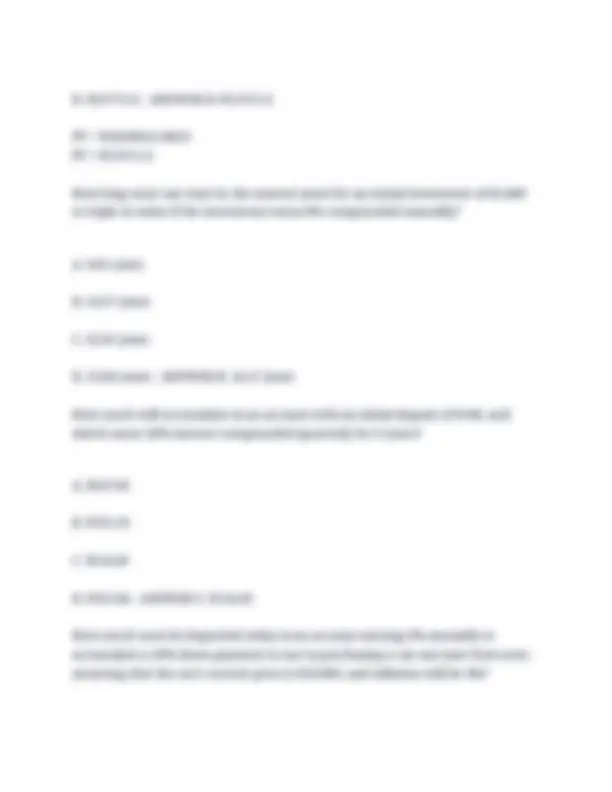
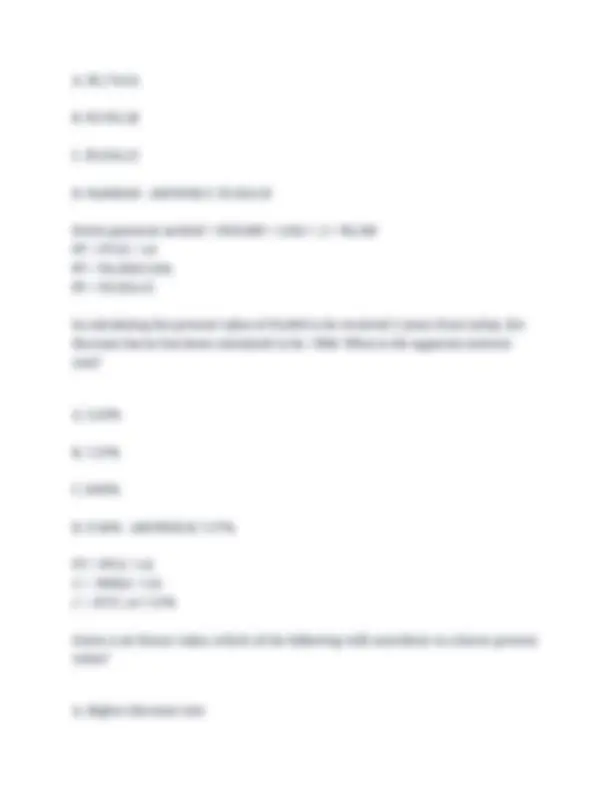
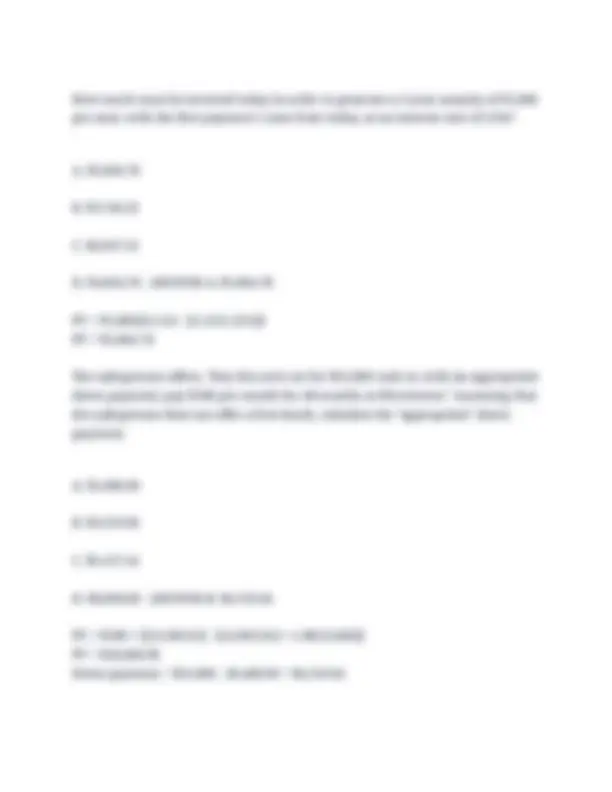
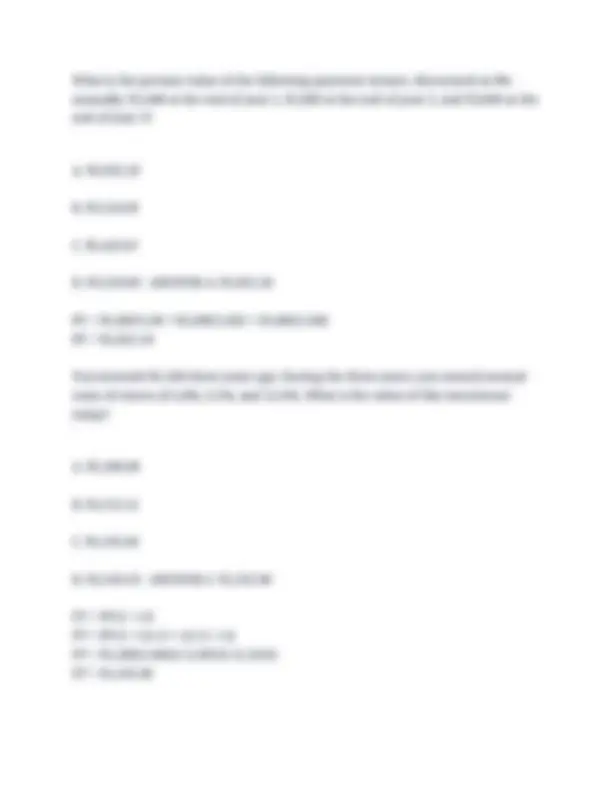
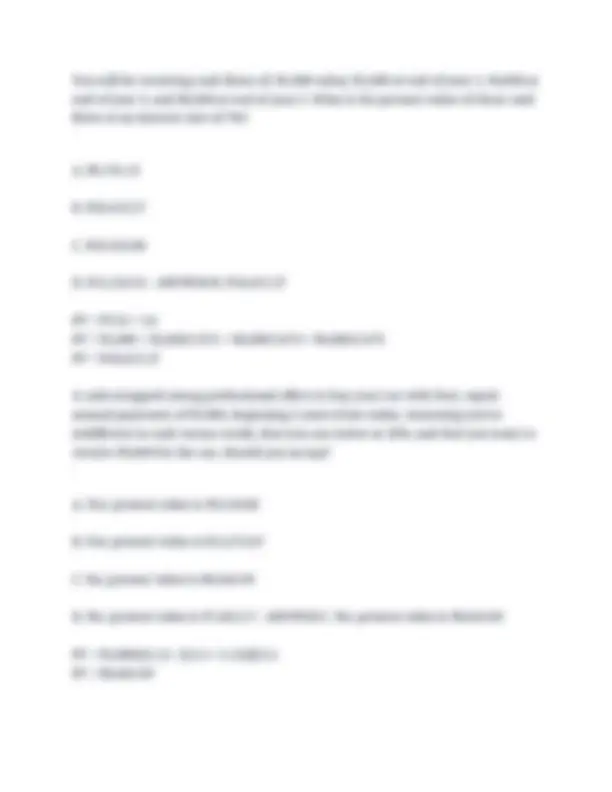
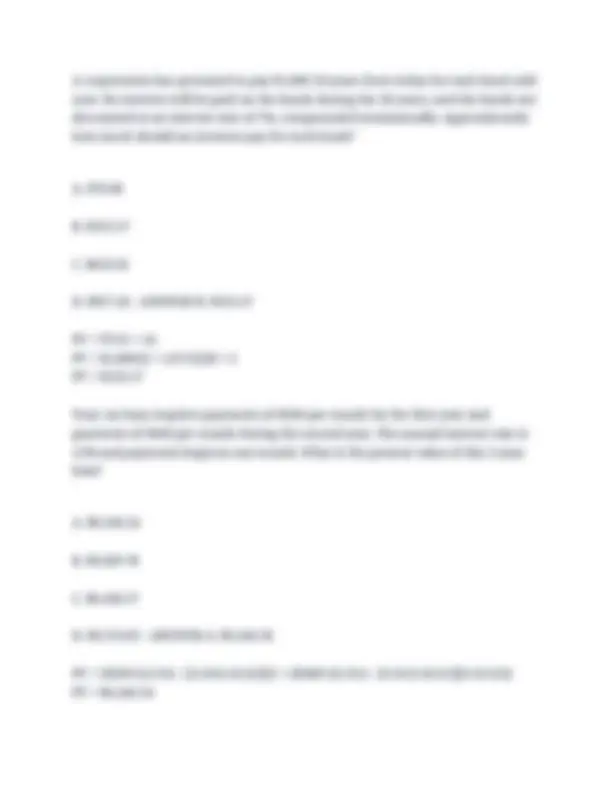
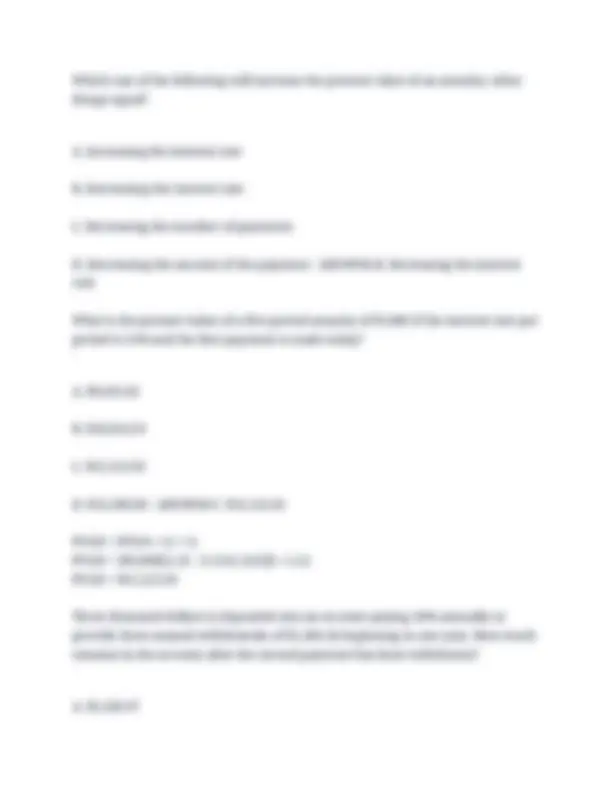
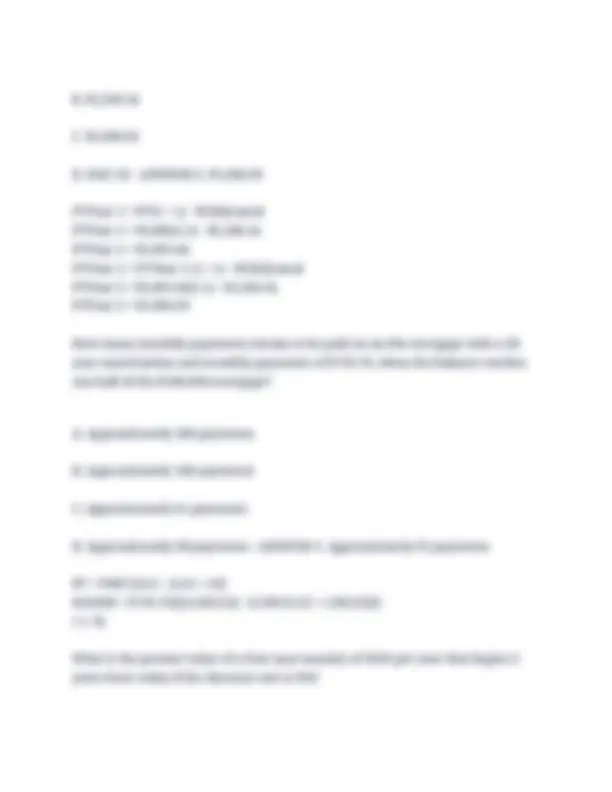
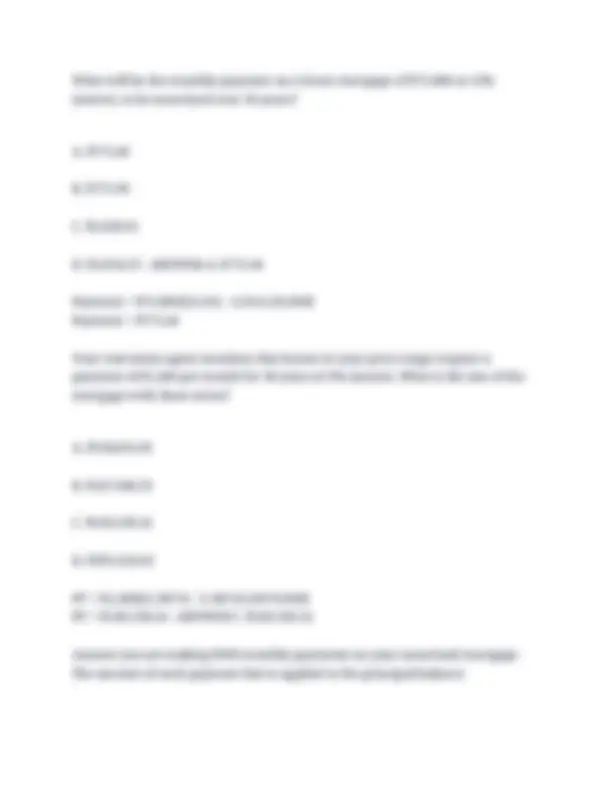
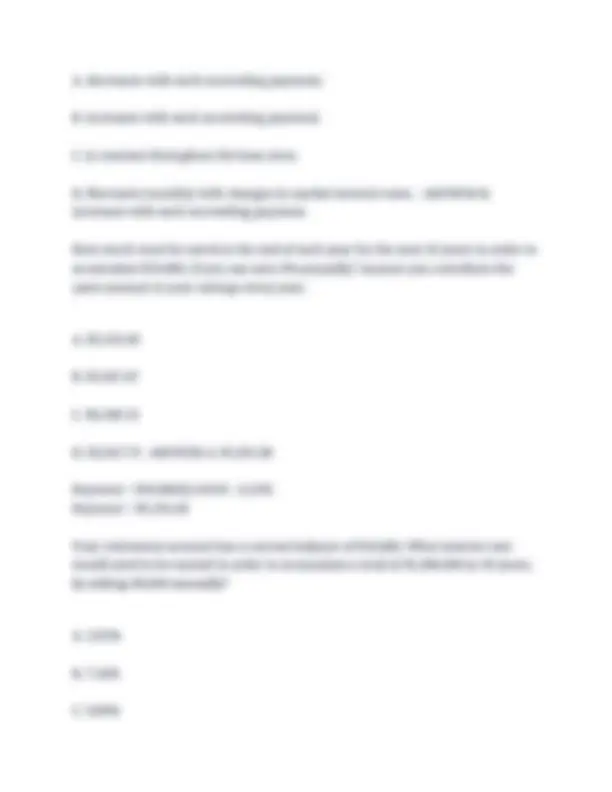
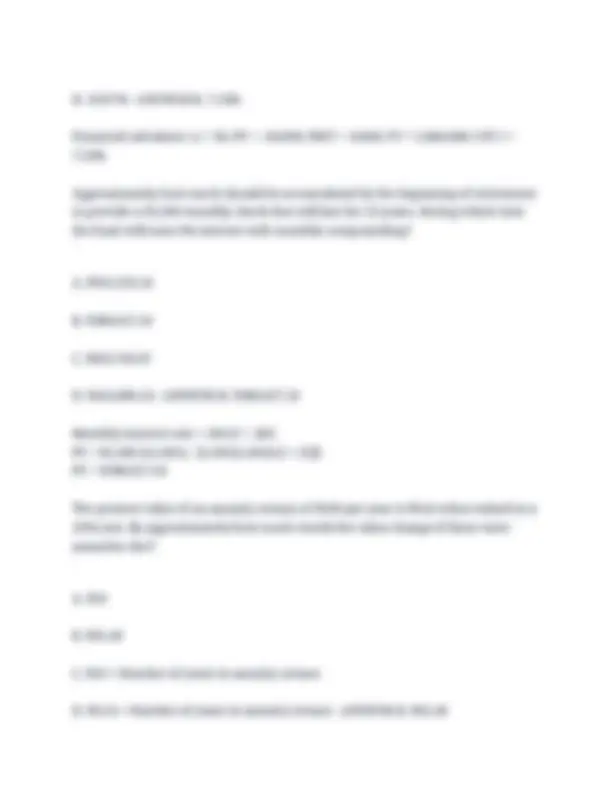
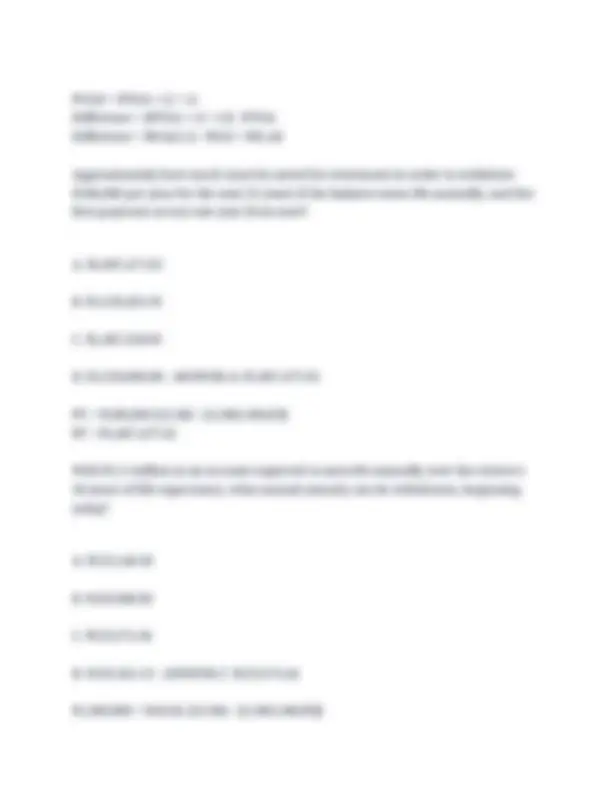
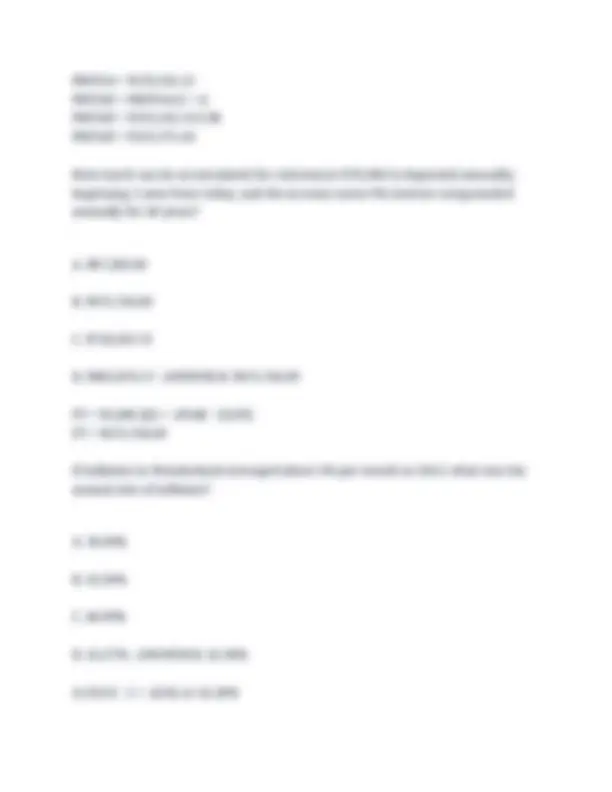
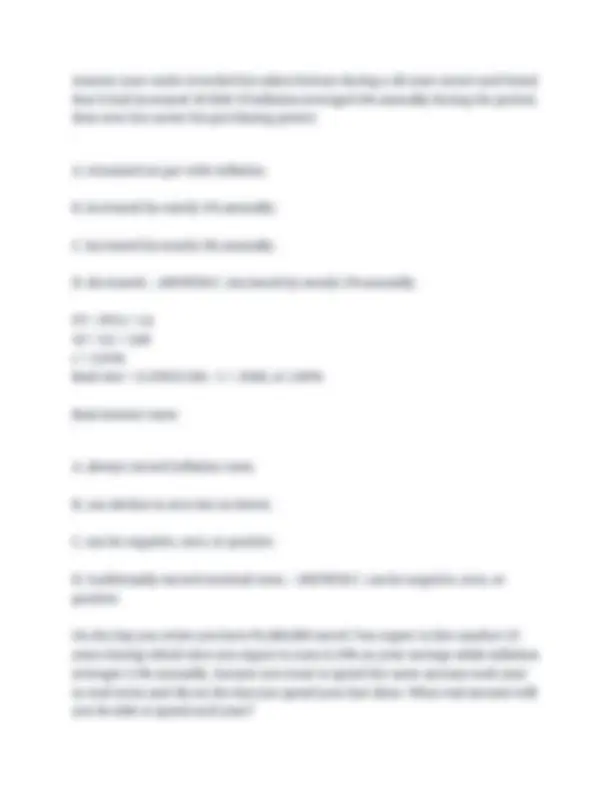
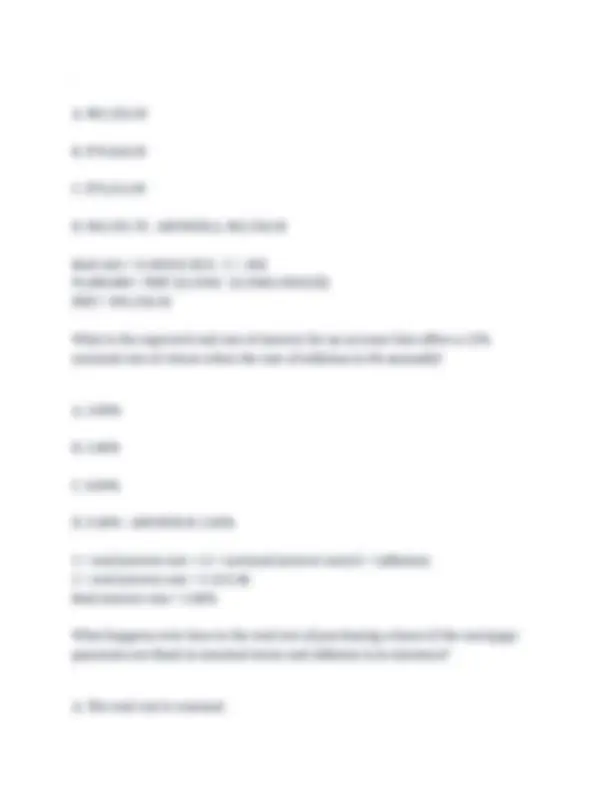
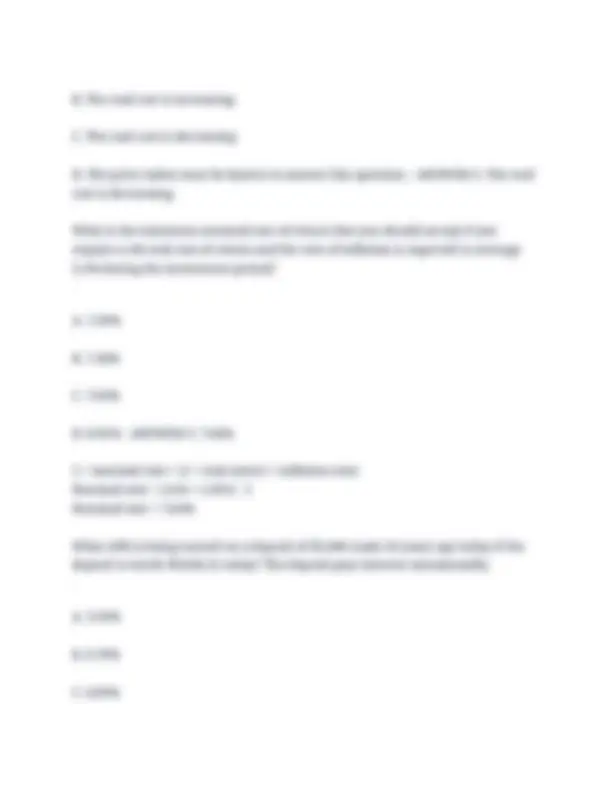
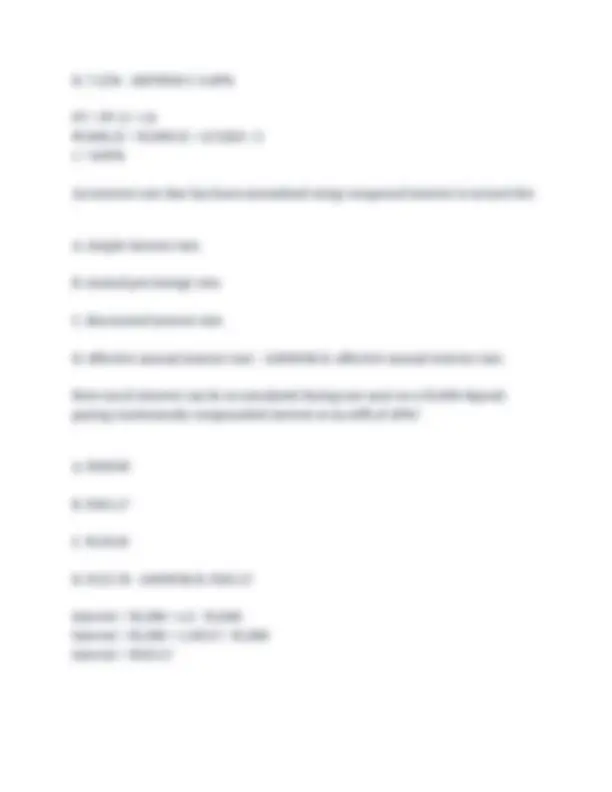
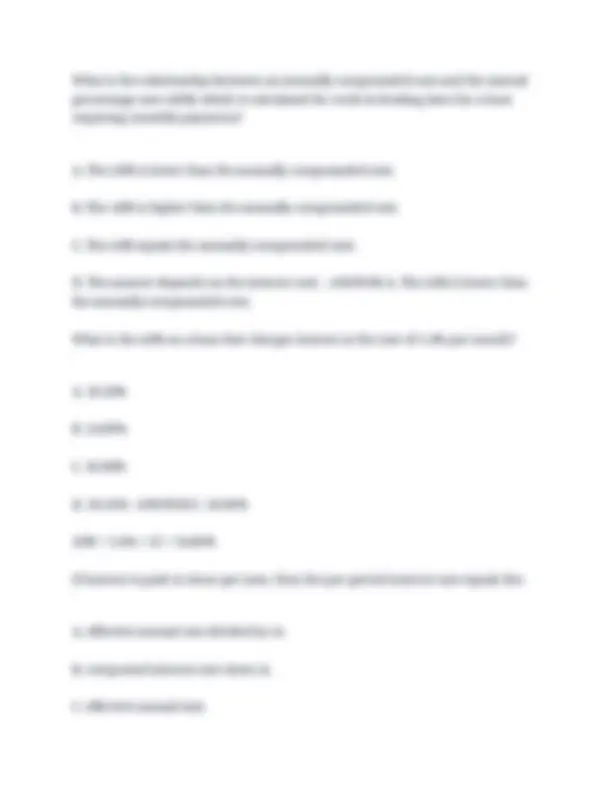
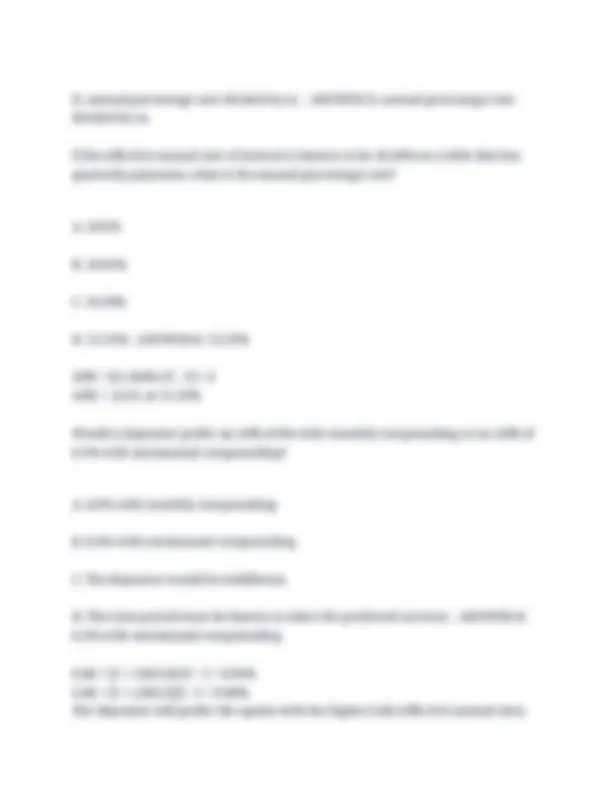
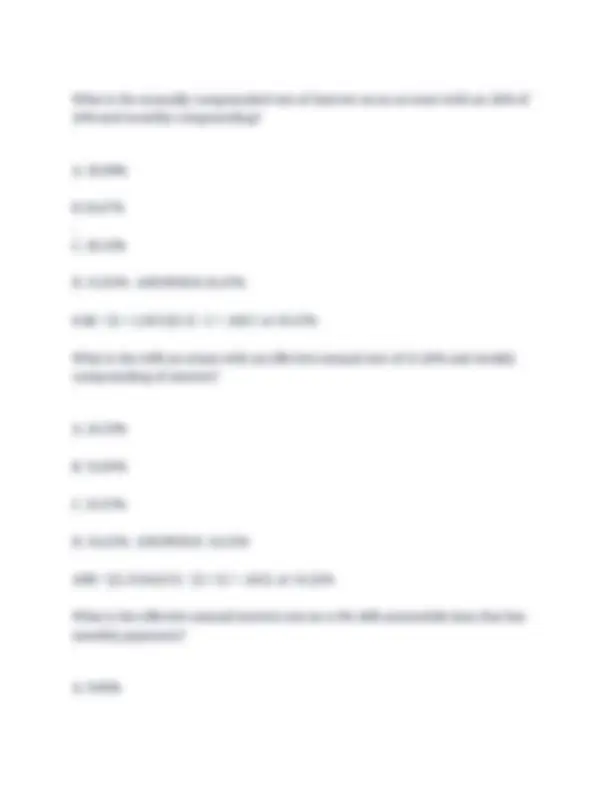
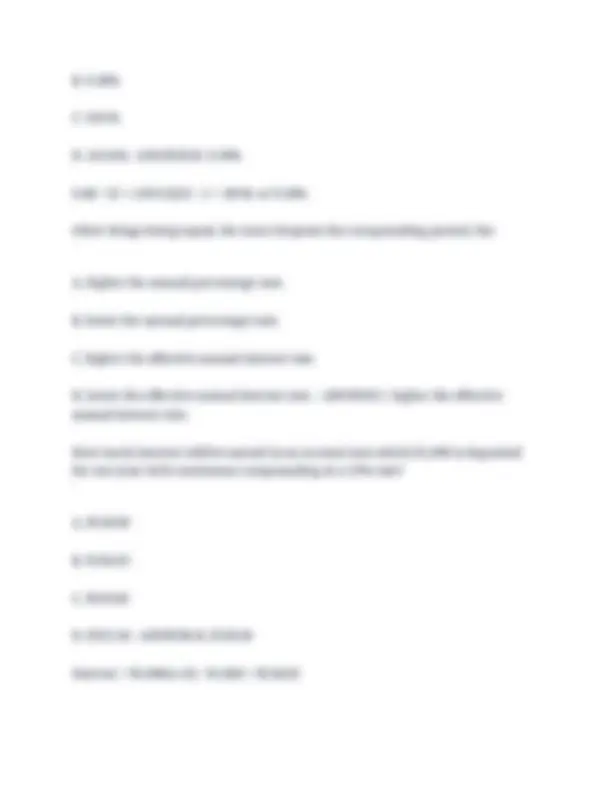
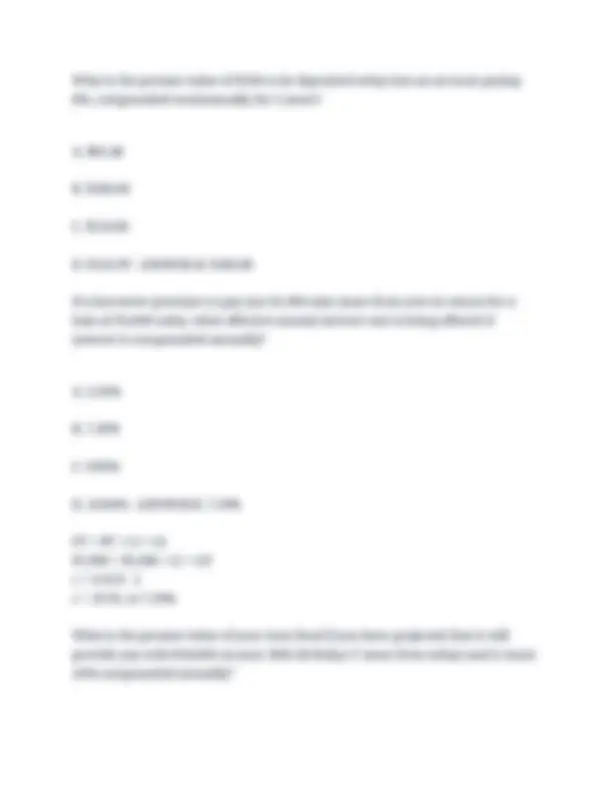
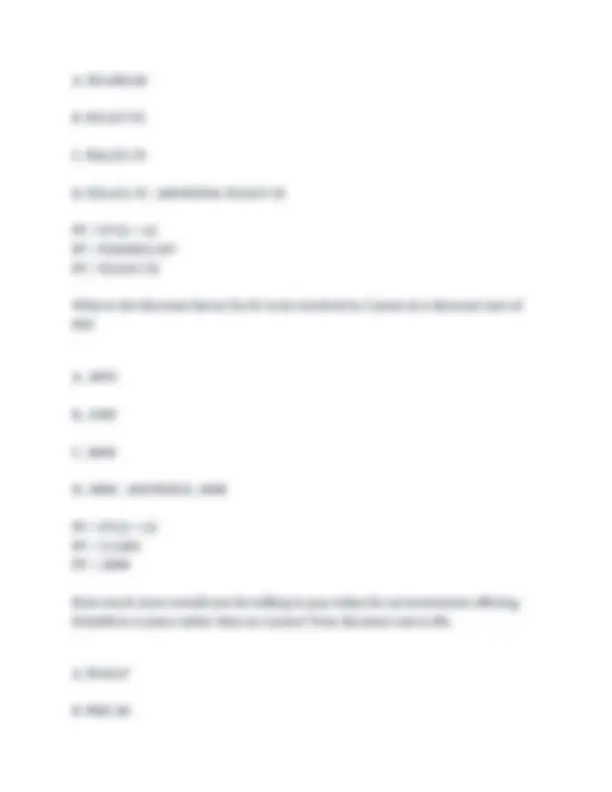
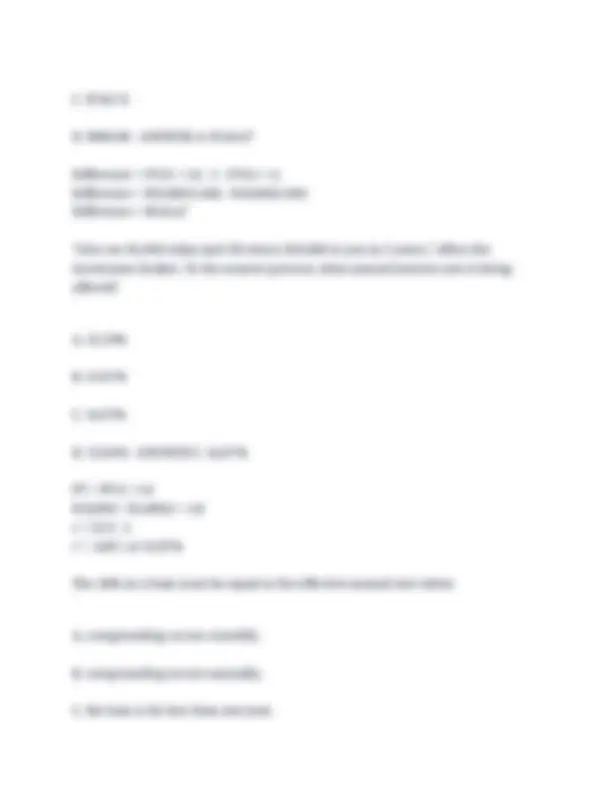
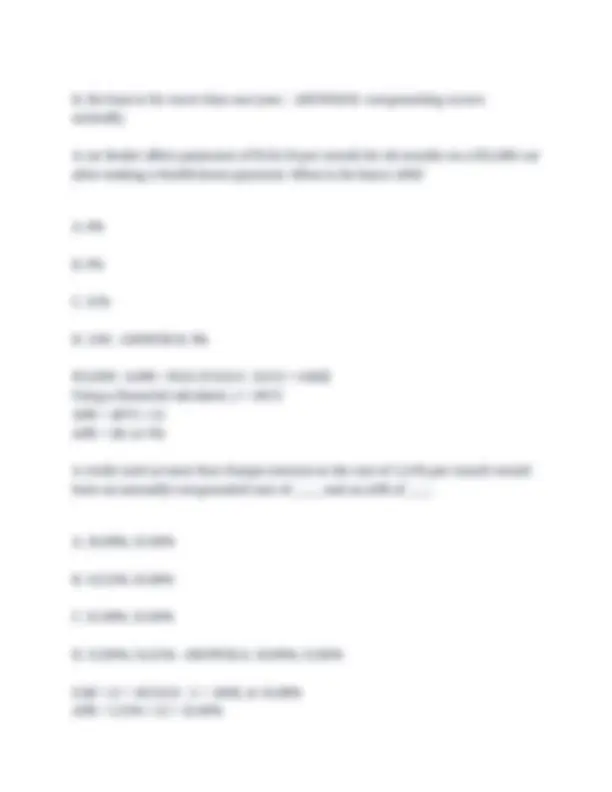
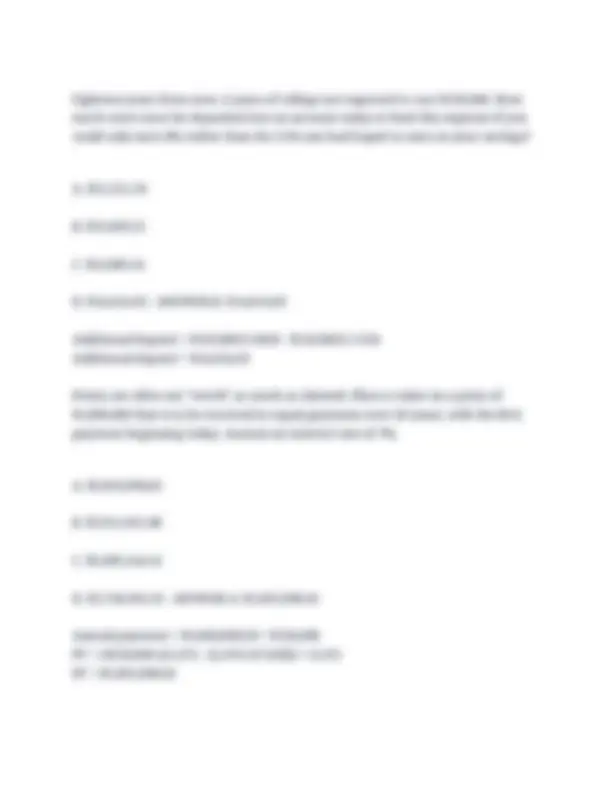
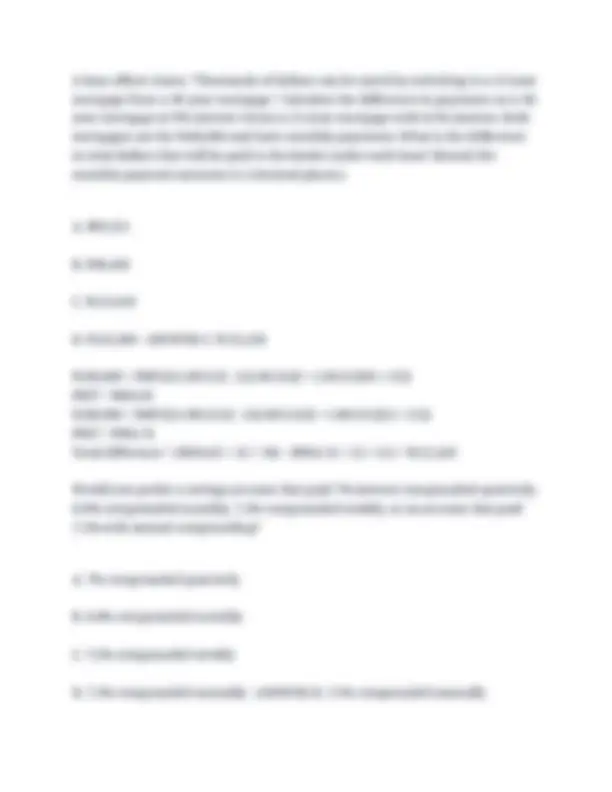
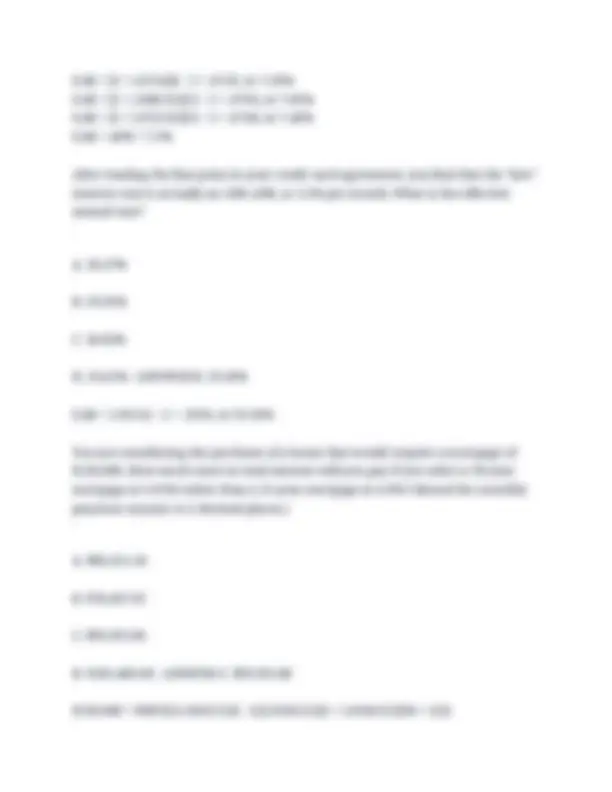
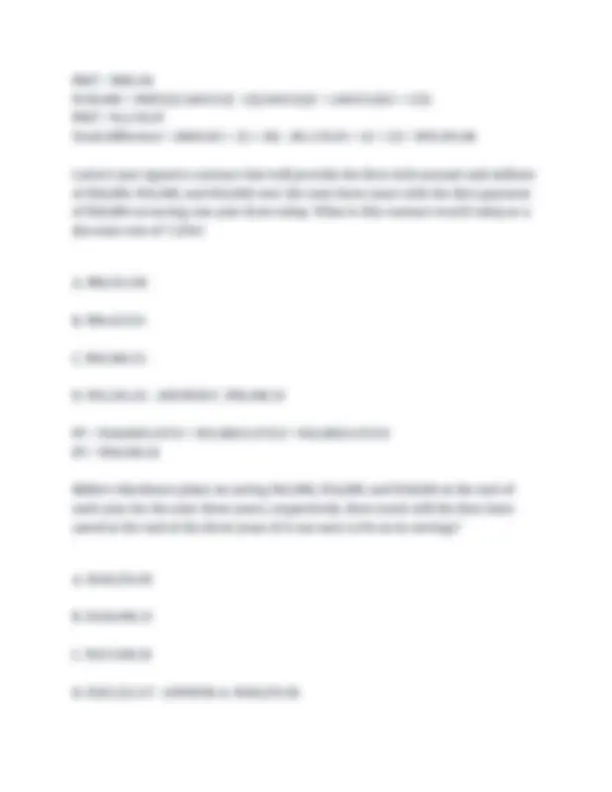



Study with the several resources on Docsity

Earn points by helping other students or get them with a premium plan


Prepare for your exams
Study with the several resources on Docsity

Earn points to download
Earn points by helping other students or get them with a premium plan
Community
Ask the community for help and clear up your study doubts
Discover the best universities in your country according to Docsity users
Free resources
Download our free guides on studying techniques, anxiety management strategies, and thesis advice from Docsity tutors
Intermediate Financial Management -- Chapter 5 exam with complete solutions.
Typology: Exams
1 / 39

This page cannot be seen from the preview
Don't miss anything!
































What is the future value of $10,000 on deposit for 5 years at 6% simple interest? A. $7,472. B. $10,303. C. $13,000. D. $13,382.26 - ANSWER-C. $13,000. FV = PV + (PV × r × t) ($10,000) + [($10,000 × .06) × 5] = $13,000. Under which of the following conditions will a future value calculated with simple interest exceed a future value calculated with compound interest at the same rate? A. The interest rate is very high. B. The investment period is very long.
C. The compounding is annually. D. This is not possible with positive interest rates. - ANSWER-D. This is not possible with positive interest rates. How much interest is earned in just the third year on a $1,000 deposit that earns 7% interest compounded annually? A. $70. B. $80. C. $105. D. $140.00 - ANSWER-B. $80. $1000.00 × (1.07)2 = $1,144.90 after 2 years $1,144.90 × .07 = $80. How much interest will be earned in the next year on an investment paying 12% compounded annually if $100 was just credited to the account for interest? A. $ B. $ C. $ D. $200 - ANSWER-C. $ The investment will again pay $100 plus interest on the previous interest: $100 × 1.12 = $
How long must one wait (to the nearest year) for an initial investment of $1, to triple in value if the investment earns 8% compounded annually? A. 9.81 years B. 14.27 years C. 22.01 years D. 25.00 years - ANSWER-B. 14.27 years How much will accumulate in an account with an initial deposit of $100, and which earns 10% interest compounded quarterly for 3 years? A. $107. B. $133. C. $134. D. $313.84 - ANSWER-C. $134. How much must be deposited today in an account earning 6% annually to accumulate a 20% down payment to use in purchasing a car one year from now, assuming that the car's current price is $20,000, and inflation will be 4%?
Down payment needed = ($20,000 × 1.04) × .2 = $4, PV = FV/(1 + r)t PV = $4,160/(1.06) PV = $3,924. In calculating the present value of $1,000 to be received 5 years from today, the discount factor has been calculated to be .7008. What is the apparent interest rate? A. 5.43% B. 7.37% C. 8.00% D. 9.50% - ANSWER-B. 7.37% FV = PV(1 + r)t 1 = .7008(1 + r) r = .0737, or 7.37% Given a set future value, which of the following will contribute to a lower present value? A. Higher discount rate
If the future value of an annuity due is $25,000 and $24,000 is the future value of an ordinary annuity that is otherwise similar to the annuity due, what is the implied discount rate? A. 1.04% B. 4.17% C. 5.00% D. 8.19% - ANSWER-B. 4.17% FVAD = FVOA × (1 + r) $25,000 = $24,000 × (1 + r) r =.0417, or 4.17% A furniture store is offering free credit on purchases over $1,000. You observe that a big-screen television can be purchased for nothing down and $4,000 due in one year. The store next door offers an identical television for $3,650 but does not offer credit terms. Which statement below best describes the cost of the "free" credit? A. 8.75% B. 9.13% C. 9.59% D. 0% - ANSWER-C. 9.59% FV = PV(1 + r)t $4,000 = $3,650(1 + r) r = .0959, or 9.59%
How much must be invested today in order to generate a 5-year annuity of $1, per year, with the first payment 1 year from today, at an interest rate of 12%? A. $3,604. B. $3,746. C. $4,037. D. $4,604.78 - ANSWER-A. $3,604. PV = $1,000{(1/.12) - [1/.12(1.125)]} PV = $3,604. The salesperson offers, "Buy this new car for $25,000 cash or, with an appropriate down payment, pay $500 per month for 48 months at 8% interest." Assuming that the salesperson does not offer a free lunch, calculate the "appropriate" down payment. A. $1,000. B. $4,519. C. $5,127. D. $8,000.00 - ANSWER-B. $4,519. PV = $500 × {[1/(.08/12)] - [1/(.08/12)(1 + (.08/12)48)]} PV = $20,480. Down payment = $25,000 - 20,480.96 = $4,519.
You will be receiving cash flows of: $1,000 today, $2,000 at end of year 1, $4,000 at end of year 3, and $6,000 at end of year 5. What is the present value of these cash flows at an interest rate of 7%? A. $9,731. B. $10,412. C. $10,524. D. $11,524.91 - ANSWER-B. $10,412. PV = FV/(1 + r)t PV = $1,000 + $2,000/1.071 + $4,000/1.073 + $6,000/1. PV = $10,412. A cash-strapped young professional offers to buy your car with four, equal annual payments of $3,000, beginning 2 years from today. Assuming you're indifferent to cash versus credit, that you can invest at 10%, and that you want to receive $9,000 for the car, should you accept? A. Yes; present value is $9,510. B. Yes; present value is $11,372. C. No; present value is $8,645. D. No; present value is $7,461.17 - ANSWER-C. No; present value is $8,645. PV = $3,000{(1/.1) - [1/(.1 × 1.14)]}/1. PV = $8,645.
How much more is a perpetuity of $1,000 worth than an annuity of the same amount for 20 years? Assume an interest rate of 10% and cash flows at the end of each period. A. $297. B. $1,486. C. $1,635. D. $2,000.00 - ANSWER-B. $1,486. PVPerpetuity = $1,000/.10 = $10, PVAnnuity = $1,000[1/.10 - 1/.10(1.10)20] PVAnnuity = $8,513. Difference = $10,000 - 8,513.56 = $1,486. A stream of equal cash payments lasting forever is termed: A. an annuity. B. an annuity due. C. an installment plan. D. a perpetuity. - ANSWER-D. a perpetuity. Which one of the following factors is fixed and thus cannot change for a specific perpetuity? A. Present value
A corporation has promised to pay $1,000 20 years from today for each bond sold now. No interest will be paid on the bonds during the 20 years, and the bonds are discounted at an interest rate of 7%, compounded semiannually. Approximately how much should an investor pay for each bond? A. $70. B. $252. C. $629. D. $857.43 - ANSWER-B. $252. PV = FV/(1 + r)t PV = $1,000/[1 + (.07/2)]20 × 2 PV = $252. Your car loan requires payments of $200 per month for the first year and payments of $400 per month during the second year. The annual interest rate is 12% and payments begin in one month. What is the present value of this 2-year loan? A. $6,246. B. $6,389. C. $6,428. D. $6,753.05 - ANSWER-A. $6,246. PV = {$200 {(1/.01) - [1/.01(1.01)12]}} + ({$400 {(1/.01) - [1/.01(1.01)12]}/1.0112)} PV = $6,246.
Which one of the following will increase the present value of an annuity, other things equal? A. Increasing the interest rate B. Decreasing the interest rate C. Decreasing the number of payments D. Decreasing the amount of the payment - ANSWER-B. Decreasing the interest rate What is the present value of a five-period annuity of $3,000 if the interest rate per period is 12% and the first payment is made today? A. $9,655. B. $10,814. C. $12,112. D. $13,200.00 - ANSWER-C. $12,112. PVAD = PVOA × (1 + r) PVAD = {$3,000[1/.12 - 1/.12(1.12)5]} × 1. PVAD = $12,112. Three thousand dollars is deposited into an account paying 10% annually to provide three annual withdrawals of $1,206.34 beginning in one year. How much remains in the account after the second payment has been withdrawn? A. $1,326.
$50,000 is borrowed, to be repaid in three equal, annual payments with 10%
Payment = $50,000/[1/.1 - 1/.1(1.1)3] Payment = $20,105. Principal payment = $20,105.74 - ($50,000 × .1) Principal payment = $15,105. An amortizing loan is one in which: A. the principal remains unchanged with each payment. B. accrued interest is paid regularly. C. the maturity of the loan is variable. D. the principal balance is reduced with each payment. - ANSWER-D. the principal balance is reduced with each payment. You're ready to make the last of four equal, annual payments on a $1,000 loan with a 10% interest rate. If the amount of the payment is $315.47, how much of that payment is accrued interest? A. $28. B. $31. C. $100. D. $315.47 - ANSWER-A. $28. $315.47 - ($315.47/1.1) = $28.
A. decreases with each succeeding payment. B. increases with each succeeding payment. C. is constant throughout the loan term. D. fluctuates monthly with changes in market interest rates. - ANSWER-B. increases with each succeeding payment. How much must be saved at the end of each year for the next 10 years in order to accumulate $50,000, if you can earn 9% annually? Assume you contribute the same amount to your savings every year. A. $3,291. B. $3,587. C. $4,500. D. $4,587.79 - ANSWER-A. $3,291. Payment = $50,000/[(1.0910 - 1)/.09] Payment = $3,291. Your retirement account has a current balance of $50,000. What interest rate would need to be earned in order to accumulate a total of $1,000,000 in 30 years, by adding $6,000 annually? A. 5.02% B. 7.24% C. 9.80%
Financial calculator: n = 30; PV = -50,000; PMT = -6,000; FV = 1,000,000; CPT i = 7.24% Approximately how much should be accumulated by the beginning of retirement to provide a $2,500 monthly check that will last for 25 years, during which time the fund will earn 6% interest with monthly compounding? A. $361,526. B. $388,017. C. $402,766. D. $414,008.24 - ANSWER-B. $388,017. Monthly interest rate = .06/12 =. PV = $2,500 {(1/.005) - [1/.005(1.005)12 × 25]} PV = $388,017. The present value of an annuity stream of $100 per year is $614 when valued at a 10% rate. By approximately how much would the value change if these were annuities due? A. $ B. $61. C. $10 × Number of years in annuity stream D. $6.14 × Number of years in annuity stream - ANSWER-B. $61.